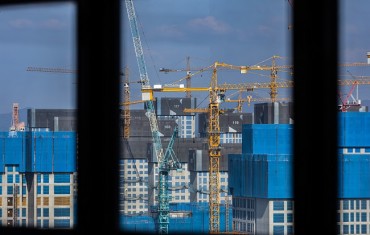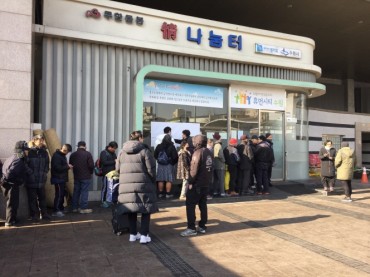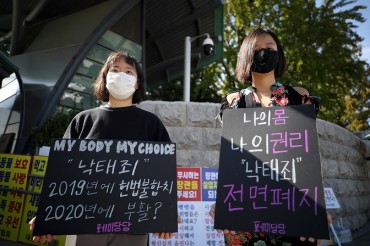
A nurse in full protective gear works at a ward for serious COVID-19 cases in Gachon University Gil Medical Center in Incheon, west of Seoul, on Nov. 16, 2021. (Yonhap)
SEOUL, Nov. 17 (Korea Bizwire) — South Korea’s daily new coronavirus cases spiked to surpass the 3,000 mark Wednesday, just shy of an all-time high, health authorities said, deepening concerns over medical capacity amid the continued surge in critical cases.
The country reported 3,187 new COVID-19 cases, including 3,163 local infections, raising the total caseload to 402,775, according to the Korea Disease Control and Prevention Agency (KDCA).
Wednesday’s figure, a sharp hike from 2,125 cases the previous day, is the second-largest figure after the all-time high of 3,270 reported on Sept. 25. It is also the second time ever that the country’s daily caseload hovered over 3,000.
The number of critically ill COVID-19 patients hit an all-time high of 522 on Wednesday, breaking the previous record of 495 a day earlier, the KDCA said.
The health authorities earlier said that they can manage around up to 500 critically ill patients in a stable manner under the current medical capacity.
The country added 21 more deaths from COVID-19, bringing the death toll to 3,158. The fatality rate stood at 0.78 percent.
As of 9 p.m. Wednesday, South Korea had reported 2,976 new cases across the country, up 163 from the previous day. The figure excluded cases from the southeastern city of Busan, which stopped releasing real-time data.
Thursday’s tally is expected to exceed 3,000 for the second day in a row. Cases are counted until midnight and announced the following morning.
The surge in the total caseload and serious cases came after the country began implementing the “living with COVID-19″ scheme on Nov. 1 that calls for easing monthslong strict antivirus restrictions for a gradual return to pre-pandemic life.
Breakthrough infections, particularly among senior citizens at nursing homes and hospitals, also led to their drastic increase, as vaccine effectiveness has been waning for those who received the shots earlier this year.
Breakthrough infections mean confirmed cases among fully vaccinated people.
Among confirmed cases, breakthrough infections accounted for 56 percent in the first week of November, up 26.3 percent from a month earlier, the KDCA said.
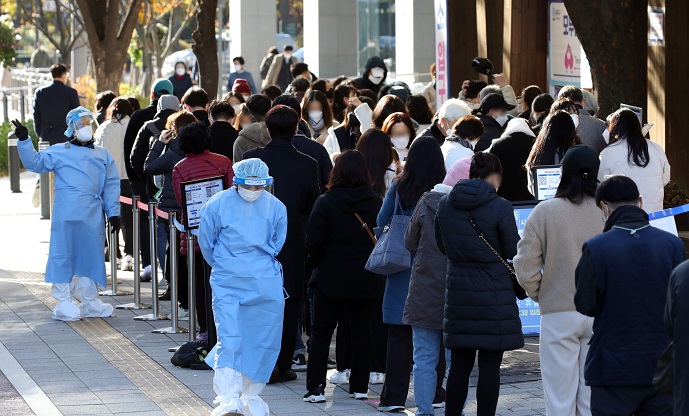
Medical workers guide people to receive coronavirus tests at a screening clinic in Seoul’s Songpa Ward on Nov. 12, 2021. South Korea’s new coronavirus cases stayed above 2,300 for the third consecutive day, and the number of serious cases hit an all time-high amid eased antivirus curbs (Yonhap)
Of the total serious cases, 440 patients, or 84.3 percent, were aged 60 or older, according to the health authorities.
The government is pushing to speed up administering booster shots to bring the virus under control and better protect senior citizens and other vulnerable groups.
The dosage interval between regular vaccination and booster shots has been shortened from six months to four months for individuals aged 60 or older, effective immediately, according to the KDCA.
Nursing home patients and workers at high-risk facilities, including hospitals, can also get extra jabs four months after being fully vaccinated. The inoculation interval for those in their 50s and soldiers, police officers and firefighters will be cut from six to five months.
The new measure, effective immediately, is expected to complete the inoculation of booster shots for those aged 60 or older and other high-risk people by December, it added.
“To cope with the current situation, additional vaccination is crucial,” KDCA commissioner Jeong Eun-kyeong said during a regular briefing. “We also judge that booster shots are quite effective against the delta variant.”
As of Wednesday, 42.06 million people, or 81.9 percent of the country’s 52 million population, had received their first COVID-19 vaccine shots. The number of fully vaccinated people came to 40.24 million, or 78.4 percent.
The government is also grappling with a growing shortage of hospital beds reserved for seriously ill patients, as well as medical workers.
The bed occupancy rate in intensive care units for COVID-19 patients stood at 62.6 percent as of 5 p.m. Tuesday.
The figure in Seoul came to 80.6 percent, which well passed the benchmark of 75 percent set by the health authorities for possible enforcement of an emergency response plan that puts a halt to the relaxation of antivirus curbs.
The capital city reported the largest-ever daily caseload of 1,432 on Wednesday, with the surrounding province of Gyeonggi and the city of Incheon, just west of Seoul, having 956 and 157 cases, respectively.
Combined, the greater Seoul area took up 79.9 percent of the total cases.
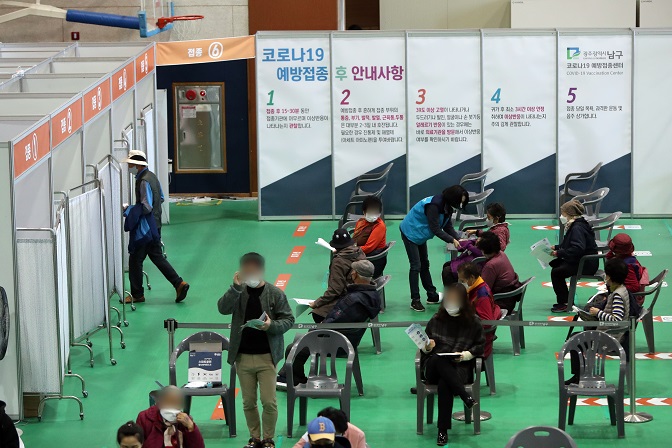
Citizens wait after receiving COVID-19 booster shots at a makeshift clinic in the southwestern city of Gwangju on Nov. 15, 2021. (Yonhap)
The health authorities, however, have said that the decision on whether to enforce any contingency plans will not just be based on numerical data but on comprehensive assessments of the virus situation, and the pandemic was still “at the manageable level.”
On Wednesday, the KDCA put forth a new five-tier system to assess the COVID-19 risk level on a weekly basis and to decide whether to continue the eased social distancing scheme.
If the risk level reaches the fourth degree or higher, the government is supposed to carry out “emergency evaluation” of the pandemic situation for the potential enforcement of contingency plans while halting the relaxed curbs.
The authorities will also immediately review whether to carry out contingency plans if hospital bed occupancy for severe cases surpasses the 75 percent threshold, according to the KDCA.
For risk assessment, the government uses 17 indicators, focusing on five key factors — bed occupancy, medical capacity, the increase in serious cases, the rate of infections among those in their 60s and older and booster rates, it added.
Under the three-phase “living with COVID-19″ scheme, South Korea plans to fully lift antivirus curbs by end-February after moving on to the second phase on Dec. 13 and to the final phase on Jan. 24, 2022.
(Yonhap)



